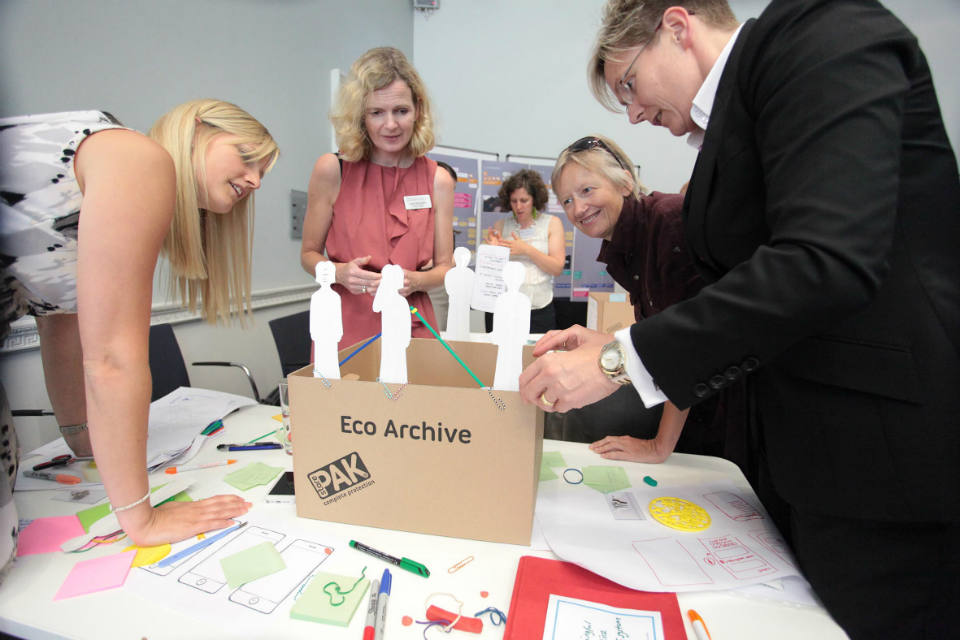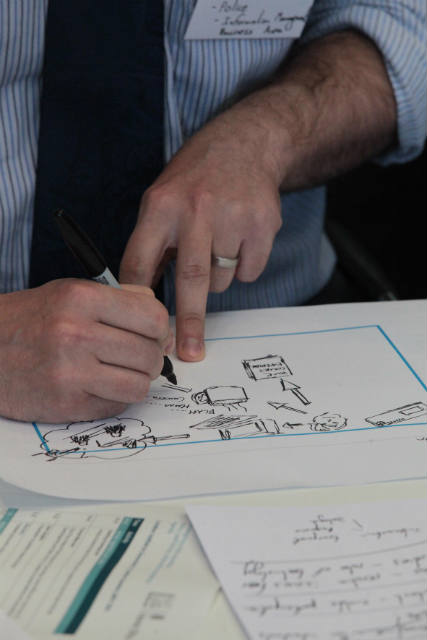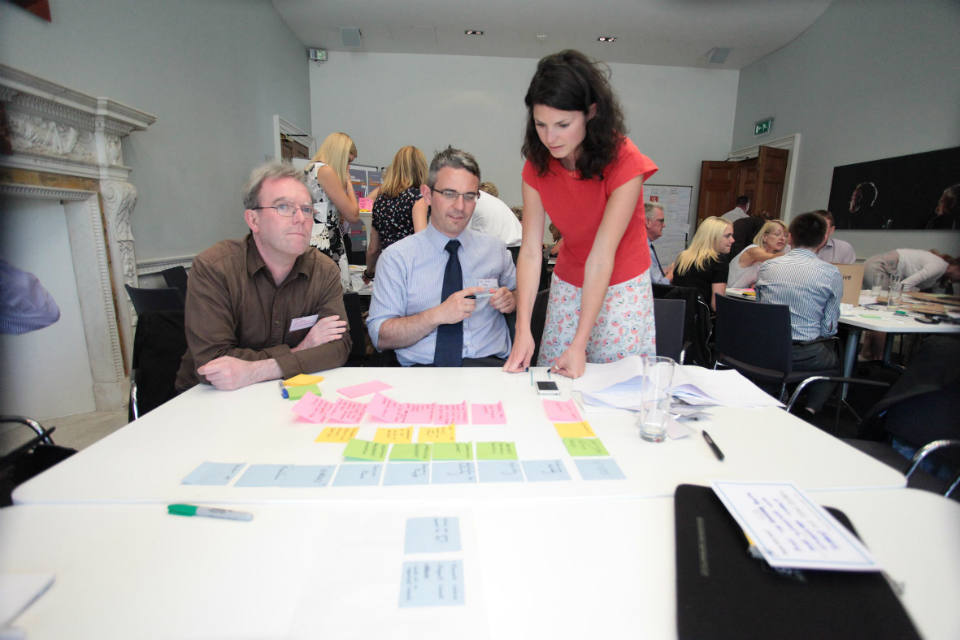What do you get when you put a graphic designer, chief constable, digital expert and a futurologist in a room and let their creative juices flow? A load of really great ideas for improving services to victims of crime, from an online skills academy where people could go to learn how to prevent crime to an online court where you could report crime, give evidence and hear the result, all from the comfort of your own living room.
And how did this eclectic mix of people come to be sitting in the Institute for Government on a sunny summer afternoon? Well, it was a key stage of the Policy Lab’s first project: on police digitisation.
Digital technology provides us with opportunities to look at things afresh. And the imperative for value for money means we absolutely have to. We cannot simply digitize analogue processes; we have to completely re-imagine how things are done. And the Policy Lab approach does just that.
As the Home Office policy official leading on digital policing, I was quick to seize the opportunity for the Policy Lab to help me try out innovative ways of approaching the problem. Surrey and Sussex were just about to embark upon a collaborative project to create a single digital service for both forces. And they were willing to try out some Policy Lab techniques to design this service around the user.
The Policy Lab approaches that we used in the project gave many clear benefits:
1. Taking a user-centred approach forces you to look at things differently. Rather than designing in our departmental silos and seeing users as a passive person we have to provide to, approaching things from the users’ perspective means that you design policy that crosses boundaries and asks what the user can do for themselves. The ethnographic research that we did prompted some questions that went far wider than just the police and threw up some ideas about what victims themselves could do, such as create an online diary of incidents so the police could easily keep track of what was happening, which Surrey and Sussex are now creating.
2. Prototyping policy – or trying an idea out small scale and getting feedback – reduces the risk of creating something that is wasteful or that people don’t want or cannot use. This can be as simple as making a paper app or a role play of how a service might be delivered. This is not a long, drawn out pilot to create evidence for a larger roll-out, but a quick way of seeing if an idea has legs.

3. Open policymaking – inviting the views of a wide range of experts – brings in fresh ideas that you may never have thought of. Catherine Howe from Public-i and Martin Innes from UPSI giving some really thought provoking presentations about the future use of technology. Catherine likened building technology to building society, challenging us to build in norms about how we want people to carry out their civic duties in relation to crime into our technological architecture. And one group did just that, building scenarios for reporting crime and giving evidence into the online game for kids, Mindcraft .
4. Visual presentation of information meant that people could soak up a large amount of information in the morning which they used to develop ideas in the afternoon. I presented the ethnographic research visually from a large 1m x 3m crime journey poster. Ruth (Uscreates) and Lisa (Surrey Office of the Police and Crime Commissioners) peppered this with insights from individual victims they had spoken to, and Julia and Sebastian (RCA) presented a video proposition for an online victims account.

5. Creative thinking techniques means that people can rapidly turn insight into ideas. After soaking up the information, Andrea Siodmok, Head of the Policy Lab, asked delegates to take an insight from the morning’s presentations, reframe it as a question, draw (yes draw, not write) a solution and then develop that solution faced with challenges such as doing it at scale, with no money at all, in 2030 etc. Drawing is a useful tool as it allows people to describe their idea much more tangibly to others. Which is what they were then asked to do, with the explicit purpose that other people could steal their idea and use it to improve their own!
Surrey and Sussex came to us with the exam question ‘how can we increase online reporting to the police from 1% to 40%?’. But through ethnographic (or observational) research with users and a collaborative workshop with a range of external experts, they ended up with ideas for an online CJS account that could take a victim through the whole process, from reporting crime to the police right through to going to court; to an online information hub where people could come together to solve local crime problems themselves without necessarily involving the police at all. These are not formal Government policy, but Surrey and Sussex can consider how they could build them to their local digital service.
It was the most buzzy and exciting day I have had in the civil service. Most people arrived at 9am, half an hour before the event formally started. When asked what we could do better, one delegate said ‘run these every day’! As well as creating new policy ideas, I hope that all the delegates left equipped with new innovative policymaking skills and the mindset – if they didn’t have it before – of the value of creating policy in an open and user-centred way. I know I’ve certainly taken these techniques back with me and tried them out with my directorate. After all, Andrea did tell us to steal good ideas!
Tell us what you think in the comments below, on <a href="https://twitter.com/OpenPolicyUK">twitter</a>, or on <a href="https://www.linkedin.com/groups?home=&gid=5139031">LinkedIn</a>.
<a href="/subscribe/">Subscribe to our email notifications</a> of new posts.

5 comments
Comment by Tony Pritchard posted on
Great article following on from an energetic workshop. With Cat Drew on board you can not only generate new ways of thinking but those ideas will look great good to. That's not an easy combination to get right – well done!
Comment by catdrew posted on
Thanks Tony! Just shows why it is great that the civil service allows you to keep learning other skills (e.g. my graphic design MA) to create multi-disciplinary policy makers!
Comment by Mike Douglas posted on
The national charity representing Neighbourhood and Home Watch throughout England and Wales, thirteen police forces, several Fire and Rescue Services and Local Authorities all use a high tech, low cost community engagement tool already.
The product: http://www.neighbourhoodalert.co.uk represents four years of re-inventing how the public sector engages with communities. It is a huge success on a tiny budget with 250,000 registered users and 3000 police administrators. Neighbourhood Watch administrators provide over £1M of volunteer administration support to all the agencies each year by providing valuable data validation services in their own areas.
it has modules for mobilising volunteers, surveying, resilience and reporting information, all designed with the requirements of the public sector but influenced by thirty years of community and Neighbourhood Watch experience.
This is a commercial product built by a British SME in close collaboration with Police, Public Sector and Neighbourhood Watch, a true example of the Business, Public and Public Sector communities redesigning the future in partnership.
What do you get when you put a graphic designer, chief constable, digital expert and a futurologist in a room without the people who already use the biggest, most successful example of what you are trying to achieve?
Comment by catdrew posted on
Hi Mike,
Thanks for highlighting neighbourhood alert. I know from when I worked closely with the Neighbourhood and Home Watch Network in 2011 that this is a great alert system to connect neighbours and prevent crime.
We did of course want to have as wide range of people there as possible, and Sam Cox and Catherine Dunn from the Neighbourhood and Home Network were at the workshop too, and they definitely brought in the perspective of what communities themselves could do to prevent crime in their area.
Comment by Tenzin Narpa posted on
thanks and it's great help!